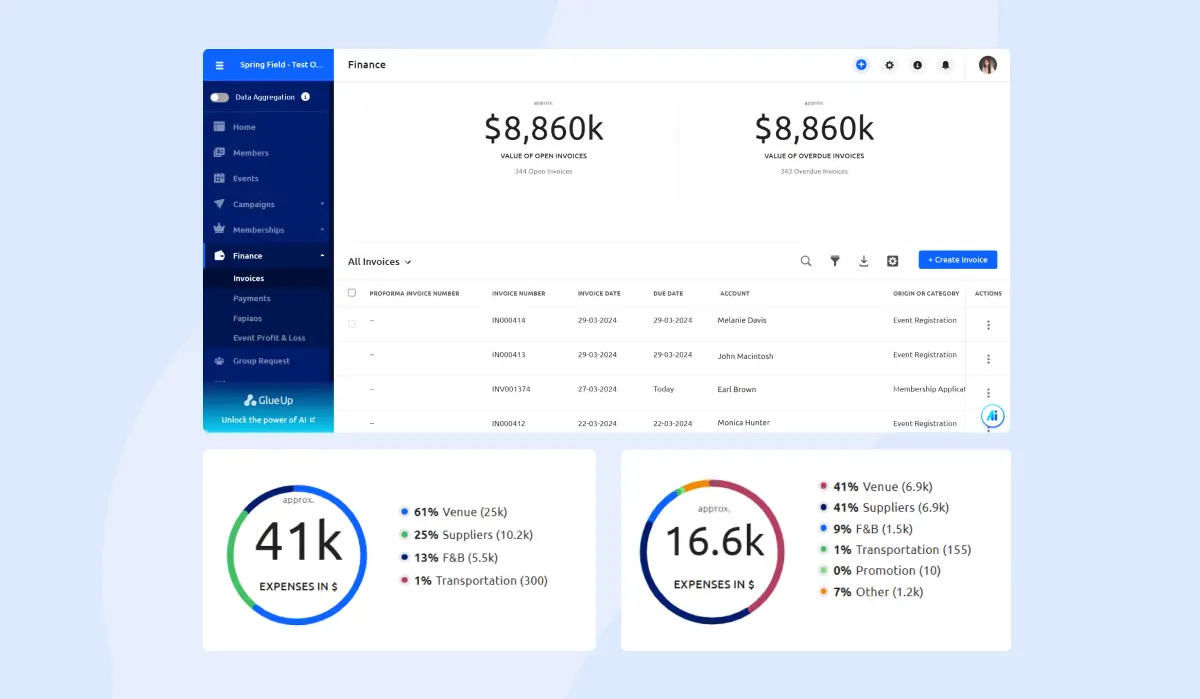
Membership dues serve as the financial backbone of any membership-based organization. Just as a strong backbone supports and sustains the body, robust membership dues mark an organization's sustainability and growth.
Yet, collecting these dues can sometimes feel daunting, and ironically, it's an area often neglected for its potential ease and efficiency.
In this blog, we'll explore the world of membership dues collection. We'll also outline the process, offer insights and practical advice on streamlining it, and certify your organization enjoys a continuous revenue cycle without interruption.
So, stay tuned as we reveal the secrets to effortless dues collection, which will set your organization on a path of uninterrupted success.
Key Takeaways
- Membership dues are foundational for the sustainability and growth of any membership-based organization. They provide essential financial support and allow organizations to deliver value and services to their members.
- Offering a variety of membership models and tiers, cater to the diverse needs and financial capabilities of their membership base, enhancing member satisfaction and retention.
- Allowing members to pay through multiple channels ensures that they can choose the method that works best for them and encourages timely payments.
- Organizations should be transparent about how dues are utilized, offer clear policies for late payments, and engage members in decision-making processes regarding dues adjustments.
- Glue Up's comprehensive membership management software streamlines the dues collection process. Its features simplify financial management for organizations and enhance the overall member experience, making It a valuable tool for sustaining and growing membership organizations.
What Are Membership Dues?
Before we discuss the complexities of dues collection, let's revisit the concept of membership dues.
Membership dues refer to a set amount charged by associations to their members in exchange for the privilege of being part of the association.
In return, members receive a range of benefits, such as access to preferred vendors, exclusive deals, discounts, insurance options, and advocacy services. Furthermore, this system is foundational to associations' operational structures, providing both financial support to the organization and value to the members.
The Importance of Membership Dues
Membership dues significantly support the financial backbone of many organizations, as a major portion of their revenue is derived from these fees. The consistent flow of membership dues largely fuels the smooth operation of these organizations.
Also, membership dues have the potential to drive great revenue, as stats suggest that 45.2% of established membership businesses bring in 6 figures each year, marking the importance of membership dues for any organization.
The collection of these dues allows organizations to offer services to their members, provide a member engagement platform, and represent their collective interests.
Therefore, membership dues are mandatory to the sustainability and existence of any member-based organization, founding its ability to fulfill its mission and deliver value to its members.
Membership Models: Multi-Year vs. Annual vs. Monthly Dues

Organizations often offer a variety of resilient membership models to cater to their members' diverse needs. Three membership models stand out as particularly common.
Multi-Year Dues
The multiple-year dues model is designed for memberships that extend beyond a single year, typically two or three years.
This model offers members the convenience and commitment of a longer-term association with the organization.
Pros
- Predictable Revenue Stream: Multi-year memberships provide a stable and predictable income, aiding in long-term financial planning and budgeting.
- Reduced Administrative Efforts: This model simplifies renewal processes, allowing the organization to dedicate more resources and time to strategic initiatives, thereby increasing operational efficiency.
- Enhanced Member Retention and Loyalty: Longer membership commitments translate to increased member loyalty, as members who opt for multi-year memberships demonstrate a deeper engagement and dedication to the organization's mission and community.
Cons
- Upfront Financial Commitment: Requires a larger initial payment from members, which might deter potential members from making a long-term financial commitment.
- Reduced Flexibility for Changes: Locking membership rates and terms for multiple years can limit the organization's flexibility to adjust prices or membership benefits in response to changing market conditions or operational needs.
- Risk of Member Disengagement: There is a risk that members may become less engaged over time, especially if they feel locked into a long-term commitment without perceiving ongoing value or if the organization's offerings become less relevant to their needs.
Annual Dues
Annual dues are the yearly fees renewed at the end of each membership year. This membership model is commonly utilized, offering a straightforward and cyclical approach to membership renewals and management.
Pros
- Flexibility for Members and Organization: Allows members and the organization to reassess and adjust membership terms and benefits annually, providing adaptability to changing needs and conditions.
- Lower Initial Financial Commitment: Members benefit from a lower upfront cost than multi-year memberships, making it more accessible for a broader range of individuals.
- Convenience of Annual Payment: Some members find it more convenient to pay once for the entire year, appreciating the simplicity of not having to worry about frequent payments.
- Predictable Revenue Prediction for Organization: Despite the potential for fluctuation, the annual model allows organizations to predict revenue based on yearly renewals, aiding in financial planning and stability.
Cons
- Potential for Membership Disruption: The yearly renewal might lead to higher turnover rates, as members reassess the value of their membership annually and may choose not to renew.
- Financial Uncertainty for Organizations: The annual model can lead to fluctuating revenue streams for the organization, making financial planning and budgeting more challenging due to the uncertainty of membership renewals each year.
Monthly Dues
Monthly dues are arguably the most common form of membership offered by organizations, providing a flexible and continuous subscription model that allows members to engage and renew on a monthly basis.
Pross
- Increased Accessibility: Lower monthly payments make membership more accessible to a wider audience, reducing the financial barrier to entry.
- Continuous Engagement: Monthly renewals keep members engaged with the organization, fostering a sense of ongoing community and involvement.
- Flexibility for Members: Provides members the flexibility to adjust or cancel their membership with minimal commitment, suiting those who prefer not to commit to long-term dues.
- Steady Cash Flow: Offers organizations a steady and predictable cash flow, with income generated consistently throughout the year.
Cons
- Administrative Overhead: Managing monthly payments can increase administrative tasks, requiring more effort to track and process recurring dues.
- Potential for Higher Turnover: The ease with which monthly memberships can be canceled may lead to higher turnover rates, as members can opt-out at any time with minimal financial impact.
- Fluctuating Revenue: While providing steady cash flow, monthly dues also introduce the potential for fluctuating revenue, as member numbers may vary more significantly from month to month.
- Challenge in Long-term Planning: The variability in membership retention on a monthly basis can make long-term financial planning and budgeting more challenging for the organization.
Understanding Membership Tiers

Just as there are various membership models, there are also membership tiers. These tiers represent membership levels, each with offerings and benefits tailored to meet members' diverse needs and preferences.
Let's understand these tiers and how they differentiate in terms of what they offer to members.
Flat Rate Memberships
The flat-rate membership model offers a uniform membership experience to all members, meaning that everyone receives the same services and benefits for a similar fixed amount.
An example of a flat rate membership is provided by the American Accounting Association, which offers a full membership at a flat annual fee of $345. This model exemplifies a straightforward and uniform approach to dues, where members pay a single set price for access to all the association's benefits and services for the year.
Another example is gym memberships, where a flat rate might grant unlimited access to the gym's facilities and classes without any tiered levels of access or additional perks, ensuring a simple and straightforward membership structure.
Tiered Membership Models
The tiered membership model operates on a level-based system, where the benefits and services available to members increase with each ascending tier.
For example, members at Level 1 receive basic services, those at Level 2 enjoy enhanced offerings, and members at Level 3 gain access to the most exclusive and premium services.
Correspondingly, membership pricing increases with each tier, similar to how airline seating is structured with the economy, first, and business class, each offering progressively more amenities and comfort at higher prices.
The tiered membership model empowers members to select the level of service that aligns with their needs and budget, making it an excellent strategy for upselling to existing customers.
Statistics reveal that existing customers are 50% more likely to try new products compared to new members, underscoring the effectiveness of offering a variety of membership options.
This approach not only caters to the diverse preferences within your member base but also leverages the increased openness of current members to explore additional offerings, enhancing their engagement and satisfaction with the organization.
Preparing to Collect Association Dues
For effective dues collection, several preparatory steps can help ensure nothing is overlooked, allowing you to make informed decisions and achieve the best results. Before you start collecting dues, you need to consider the following actions:
Evaluate Your ROI
The ROI evaluation (Return on Investment) determines whether your association is profitable or incurring losses. A positive ROI signifies profit, while a negative ROI indicates a loss. Typically, ROI represents the return amount after expenditures on various association functions, such as operational costs or membership benefits.
For this, you need to list all your expenses and subtract them from your dues amount. The remaining amount would be your ROI. If it's positive and substantial, then that's good. If not, you need to strategize and reconsider your approach.
Establish a Clear Collection Schedule
To ensure effective dues collection, you must develop a clear collection schedule. Decide whether you will collect dues monthly or annually. If you choose a monthly collection, you will have a steadier stream of revenue, but there is a risk that members might leave after just one or two months.
On the other hand, opting for an annual collection will bring in more revenue at once, but you will only receive it once a year. However, members are more likely to stay throughout the year. If you're still unsure, consider offering monthly and annual options to cater to different preferences.
Create a Communication Plan
Effective member communication is crucial. Develop a communication plan and engage with your members regularly. They may want to know how their fees are used, so provide clarity. Instead of viewing them merely as members, consider them as individual stakeholders.
For instance, inform them that a portion of their dues will upgrade the association's technology for better member services. Alternatively, explain that their dues will fund community outreach programs to boost engagement.
This approach ensures transparency, allowing members to understand how their dues are utilized.
Consider Offering Incentives
Offer incentives to your members to encourage participation. For example, consider offering a 10% to 20% discount to members who upgrade their membership plans.
Additionally, you could offer a 50% discount on the twelfth month's payment to members who consistently pay for eleven months.
These incentives can also take the form of discounts on other services, such as groceries or travel.
How Much Should You Charge for Membership Dues?
Setting the pricing for membership dues involves a multifaceted approach. Several critical factors must be considered to ensure the organization's financial sustainability and member satisfaction.
Initially, it's essential to calculate an average cost that encompasses all operational expenses and includes a margin for profit. This figure should ideally serve as the baseline for your membership dues.
In addition to internal cost calculations, an analysis of the competitive landscape is crucial. Understanding the services offered by competitors and their corresponding fees is key to positioning your organization competitively.
Furthermore, it is vital to assess the financial status of potential and current members. Analyzing how much they can pay for membership dues without causing financial strain is important for maintaining membership levels and ensuring accessibility.
Lastly, and perhaps most importantly, the value of the services offered in relation to the set membership price must be carefully considered and clearly justified.
Members should feel that they are receiving significant value for their investment. When members perceive that they are valued and their voices are heard within the organization, they are more likely to be open to paying higher fees.
Therefore, ensuring that your members feel valued by offering them substantial benefits and opportunities for engagement is essential for the sustainability and growth of the organization.
How to Increase Your Membership Dues?
Increasing membership dues can be manageable, primarily based on effective communication with your members and clearly explaining the rate change.
However, before initiating this conversation, it's crucial to address the following question:
Why Would You Increase Membership Dues?
The general reasons for increasing membership fees typically revolve around the organization's need to adapt to changing circumstances and enhance its offerings. These reasons can include:
- Expansion Goals: The organization may aim to grow or expand its services, necessitating additional revenue to support these ambitions.
- Increasing Member Benefits: There might be a desire to increase the value provided to members through additional or improved benefits, which requires more funding.
- Operational Costs and Inflation: To maintain operational viability and keep pace with inflation, adjusting membership fees may be necessary to cover increasing costs.
Each of these reasons suggests the organization's commitment to its mission and its members, ensuring it continues providing value while meeting its financial and operational objectives.
How to Communicate Membership Dues?

Before setting dues or increasing membership dues, engaging with your members and gaining their confidence through transparent communication is crucial. There are several effective ways to communicate with members, including:
Be Transparent
Transparency with your members is critical when you intend to increase the fees. Clear and straightforward communications, especially regarding changes affecting your members, build trust and strengthen the community bond.
This transparency ensures members feel respected and valued, promoting loyalty and long-term organizational engagement.
Explain Why
It's imperative to clearly explain to your members the reasons behind the decision to increase fees and ensure they understand the necessity for this adjustment.
Transparency about why the increase is essential to enhancing member benefits, covering operational costs, or accommodating expansion helps members understand and accept the change.
Communicating the rationale with sincerity shows respect for members' investment in the organization and reinforces the mutual goal of improving the membership experience.
Re-Emphasize Your Organization’s Value
Emphasize your organization's core values to your members, highlighting how deeply it values its members and its commitment to providing them exceptional benefits and services.
Make it clear that every decision, including fee adjustments, is made with the members' best interests in mind, aiming to enhance the overall member experience, expand the range of offerings, and ensure the organization's continued growth and sustainability.
Offer Flexibility
Offer some flexibility in your approach to increasing membership fees. Be open to negotiations and consider offering discounts for a specified period to ease the transition for your members.
Additionally, it is important to provide a generous notice period before the fee increase takes effect, allowing members ample time to adjust to the change.
Top Tips on Collecting Membership Dues
Here are effective tips on how to collect membership dues:
Start Early
If your membership dues are approaching, it's important to remind members well in advance rather than waiting until the last moment. Start the reminders a week or two before the due date for monthly dues, giving members ample time to prepare for the payment.
For annual dues, initiating reminders at least one month in advance is suitable, ensuring members have sufficient notice to accommodate the payment in their financial planning.
Personalize Your Reminders
Always personalize your reminders rather than relying on generic, automated messages for everyone. When personalizing, include details specific to the member, such as their name, membership level, and any relevant benefits or services they enjoy. This approach makes members feel valued and recognized as important individuals within the organization.
Allow Your Members to Pay Online
Offer your members the most convenient payment options available, including the ability to pay dues online. Online payment methods allow members to complete transactions with just a few taps, simplifying the process significantly.
Overall, this convenience drives the stellar member experience, fitting into their digital lifestyles and encouraging prompt payments.
Be Lenient
Adopt a lenient approach to collecting membership dues. If members forget to pay their fees on time, consider offering them a grace period to settle their dues. Being understanding and flexible demonstrates compassion and prioritizes the member relationship over strict adherence to deadlines.
The Best Way to Collect Membership Dues

It's time to discuss the practical aspects of collecting membership dues, a crucial component for sustaining the operations and services of any membership-based organization.
Let's explore the various effective strategies and methods available for dues collection:
Optimized Membership Forms
Provide custom membership forms designed for ease and efficiency for your members. Verify that the form clearly displays all the membership benefits, offering a transparent overview of what members gain by joining or renewing.
Incorporate alternative payment methods into the form to accommodate your members' varied preferences. This will make it convenient for them to choose their preferred method.
Additionally, include an option for automatic renewal. This feature not only simplifies the process for members, saving them time and effort by eliminating the need to renew each term manually but also ensures a steady membership base and revenue stream for the organization.
Automated Payment Processing
Automated payments simplify the process both for members and the organization. Moreover, this feature allows members to opt for auto-renewal of their membership and ensures their continued access to benefits without the need for manual intervention each cycle.
This convenience enhances the member experience by making renewals effortless. It also aids the organization in maintaining a steady revenue stream and reducing the administrative workload associated with tracking and processing renewals.
Member Self-Service
Allowing members to edit and update their payment details or payment plans empowers them with control over their accounts and financial commitments to the organization. This flexibility ensures members can easily adjust their payment information in response to changes in their financial situation or preferences.
Providing members with the ability to manage their own payment details improves their experience by offering them autonomy and convenience and reduces the organization's administrative burden.
Integration With Payment Gateways
Many members prefer using their digital wallets and payment solutions, such as PayPal or Stripe, for online transactions. Organizations can benefit from integrating third-party payment gateways into their payment systems.
However, this integration facilitates members by allowing them to pay via their desired channels, amplifying their convenience and satisfaction.
Tiered Memberships
Offering tiered membership helps collect dues effectively by providing members with multiple options, allowing them to select the tier that best suits their needs and financial capacity.
This flexibility acknowledges the diverse preferences and circumstances of the membership base, encouraging more individuals to join or renew by finding a level of engagement and investment that is comfortable for them.
Member Communication
Enable options within your system to communicate effectively with members, notifying them of upcoming payments, payment confirmations, and other important updates. Establishing these communication channels ensures that members are well-informed about their financial commitments and any processed transactions.
Financial Reporting
Review your annual financial reports to monitor dues collection and your organization's overall financial health. Additionally, consider sharing these reports with your members to demonstrate transparency and accountability.
Data Security & Compliance
Maintaining data security is essential for any organization, especially when handling financial transactions and personal member information. Therefore, to safeguard against potential threats and data breaches, implement robust firewalls and encryption measures around your system.
Additionally, it is mandatory to comply with relevant data protection regulations and standards. However, this involves increasing your data security and protocols to comply with the latest guidelines and legal requirements.
Streamlined Financial Reconciliation
Transactions are recorded when collecting dues through membership management software like Glue Up, promoting transparency and accuracy in the organization's financial dealings.
This automated approach dramatically reduces the risk of errors common with manual processing, ensuring straightforward and reliable financial reconciliation.
Are you interested in seeing how Glue Up can streamline your dues collection process and enhance financial transparency within your organization? Book a demo today to discover the efficiency and security this comprehensive membership management solution can provide.
Check Payments
Allow your members the option to pay their dues via check. While it may seem somewhat outdated or traditional in today's digital age, paying by check remains a straightforward and accessible payment method for many.
Encourage members to mail their checks directly to the organization. This method caters to members who prefer this payment method and helps the organization save on third-party processing fees associated with online payments.
Flexible Payments
Consider accepting installment payments, particularly for multi-year and annual subscriptions. A structured payment plan, such as 50% at the beginning, followed by 20% after six months, and the remaining balance towards the end of the subscription period, can significantly enhance member satisfaction.
This approach makes the financial commitment more manageable for members, easing concerns about making full payments upfront.
Incentivize Timely Payments
Offer incentives or discounts on services to members who make their payments on time. This approach encourages punctuality in dues payment and rewards members for their commitment and reliability.
Token of Appreciation
Members who consistently renew their membership should consider implementing a credit points system as a reward for their loyalty.
For instance, if a member has continuously renewed a monthly subscription for 11 months, offer the 12th month free as a token of appreciation.
This gesture acknowledges their ongoing support and encourages continued membership, fostering a strong sense of community and loyalty within the organization.
7 Membership Dues FAQs
Now, let's address the questions often asked about membership dues.
1. How Frequently Should We Review and Adjust Membership Dues?
It is recommended that membership dues be reviewed and adjusted annually after the conclusion of each financial year. In cases where an urgent adjustment is needed, it's crucial to communicate transparently with members about the reasons behind the change before proceeding.
2. What Payment Methods Should We Offer for Membership Dues?
Give your members the freedom to pay through various channels, recognizing each member's preference. Offering a wide range of payment methods, including credit cards, digital wallets, bank transfers, or even checks, accommodates the diverse needs of your membership base.
3. How Can We Maintain Transparency About How Membership Dues Are Used?
Transparency is key to building your members' trust in your organization. Be open about the dues by publishing your financial reports and detailing how the dues are spent.
This level of transparency assures members that their contributions are being managed responsibly and are directly supporting the organization's goals and activities.
4. Should We Offer Different Levels of Membership With Varying Dues?
Yes, offering multiple membership levels is a strategic approach that provides members with diverse options, making it easier for them to select the tier that best suits their needs and preferences.
This flexibility allows members to customize their membership experience according to their specific interests, budgets, and the benefits they value most.
5. How Should We Address Late or Non-payment of Membership Dues?
Set clear policies for late payment, including potential consequences, to ensure members know the implications of delayed dues.
Additionally, a grace period should be introduced to offer flexibility and understanding to members who occasionally face unforeseen circumstances that prevent on-time payment.
This balanced approach demonstrates the organization's commitment to fairness while maintaining the importance of financial obligations.
6. What Are the Tax Implications for Collecting Membership Dues?
The tax implications for membership dues can vary significantly from one organization to another, depending on whether your organization is exempt from taxes or not.
Additionally, tax regulations and exemptions can differ from state to state, affecting how dues are processed and reported. Organizations should understand their specific tax obligations and exemptions to ensure compliance with local and federal tax laws.
7. How Can We Encourage Members to Set up Automated Dues Payments?
Educate your members on the convenience and time-saving benefits of automated dues payments. Consider offering a discount or other incentives to encourage them to use automated payments.
This approach promotes a more efficient payment process for both the member and the organization and enhances member satisfaction by offering a tangible reward for choosing a more convenient payment method.
Streamline Your Dues Collection with Glue Up

Glue Up is a leading association management software designed to empower organizations by streamlining administrative tasks, enhancing member engagement, and fostering growth.
Glue Up's robust set of tools simplifies the management of finance processes, allowing you to automate dues collection and significantly increase revenue.
Let's explore what makes Glue Up the comprehensive solution for organizations looking to streamline their operations and member experience.
- Local Payment Methods: Integrates local payment options to provide convenience for members in different regions.
- In-person Payments: Allows for processing payments made in person, offering flexibility for events and meetings.
- Enable Secure & Smooth Payments: Ensures secure transactions, protects member information, and provides a seamless payment experience.
- Automatic Invoicing: Generates invoices automatically, streamlining billing processes and ensuring timely notifications to members.
- Custom Reminders & Notifications: Sends tailored reminders and notifications to members about due payments, enhancing timely collection.
- Customizable Tax Setup: Adapts to various tax regulations, enabling accurate and compliant financial management.
- Coupons & Discounts: Offers the ability to apply discounts or coupons, encouraging early payments or rewarding loyalty.
- P&L Reports: Provides profit and loss reports for detailed financial oversight and planning.
- Real-time Analytics: Delivers insights into payment trends and member behaviors, aiding in strategic decision-making.
These features collectively make Glue Up a comprehensive tool for managing dues collection, ensuring efficiency, security, and member satisfaction.
Want to discover how Glue Up can transform your organization's dues collection process? Book a demo today and explore the full range of features designed to streamline your financial management and grow your revenue.



